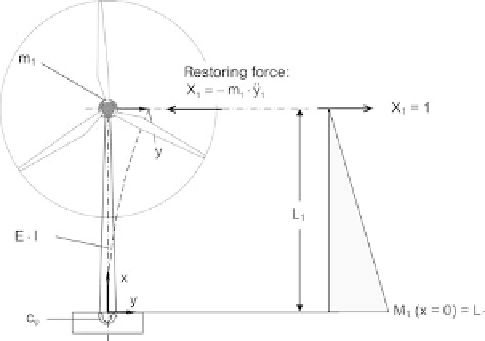Environmental Engineering Reference
In-Depth Information
Fig. 4.4 Modelling a tower as a mass-spring system with a single degree of freedom
tower approximately when its mass is mainly concentrated in the nacelle and its centre
of gravity can be assumed to be located there, too (Figure 4.4).
The equation of motion for a mass-spring system with a single degree of freedom can
be formulated according to D'Alembert's principle as an equilibrium condition:
m
1
€
y
1
þ
X
1
¼
0
The displacement y
1
can be determined with the work theorem:
y
1
¼
X
1
k
11
with the following deformation modulus:
Z
x
¼
L
1
M
1
E
I
dx
þ
L
1
3
E
I
þ
L
1
c
w
M
1
x
¼
0
ð
Þ
k
11
¼
L
1
¼
c
w
x
¼
0
Substituting the first equation in the second gives us the Euler differential equation for
the mass-spring system with a single degree of freedom in the following form:
y
1
¼
m
1
€
y
1
k
11
Using the formula for the fundamental mode
y
1
¼ ^
v ð Þ
results in the equation for determining the damped angular frequency
y
1
sin
v
:
2
k
11
From this we get the period of oscillation:
1
¼
m
1
v
p
m
1
k
11
2
p
v
T
¼
¼
2
p
In order to ascertain the distribution of mass more accurately, we can employ a modal
analysis to investigate a mass-spring system with multiple degrees of freedom and a
finite number of discrete individual masses. A model with just a few concentrated



